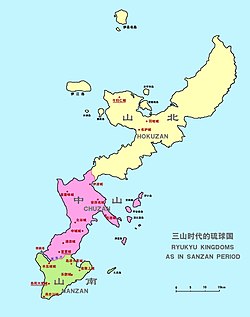Chūzan
| Kingdom of Chūzan | ||||||||
| 中山 | ||||||||
|
||||||||
|
Map of the Three Kingdoms (Sanzan) of Okinawa, with Chūzan in purple.
|
||||||||
| Capital | Urasoe | |||||||
| Languages | Ryukyuan, Chinese | |||||||
| Religion | Ryukyuan religion | |||||||
| Government | Monarchy | |||||||
| King (国王) | ||||||||
| • | 1314–1336 | Tamagusuku | ||||||
| • | 1355–1397 | Satto | ||||||
| • | 1398–1406 | Bunei | ||||||
| • | 1422–1429 | Shō Hashi | ||||||
| History | ||||||||
| • | Established | 1314 | ||||||
| • | Ryukyu unification | 1429 | ||||||
| • | Japanese invasion | 5 April 1609 | ||||||
|
||||||||
Chūzan (中山) was one of three kingdoms which controlled Okinawa in the 14th century. Okinawa, previously controlled by a number of local chieftains or lords, loosely bound by a paramount chieftain or king of the entire island, split into these three more solidly defined kingdoms within a few years after 1314; the Sanzan period thus began, and would end roughly one hundred years later, when Chūzan's King Shō Hashi conquered Hokuzan in 1419 and Nanzan in 1429.
The united Okinawan state was called the Ryūkyū Kingdom, but would continue to be referred to as "Chūzan" in various official documents of the Ryukyuan royal government, and those of many other states in the region.
Tamagusuku succeeded his father Eiji as king of Okinawa at the age of nineteen, in 1314. However, he lacked the charisma or leadership abilities to command the respect and loyalty of the various territorial lords (aji), and many rebelled soon afterwards. The Lord of Ozato fled south and, along with his followers, formed the kingdom of Nanzan (南山, Southern Mountain), while the Lord of Nakijin, based some distance to the north, declared himself king of Hokuzan (北山, Northern Mountain). Thus, Tamagusuku, in Urasoe, became king of Chūzan.
Tamagusuku died in 1336, and was succeeded by his son Seii, then ten years of age. Seii's reign was relatively short, and defined by the interference and political abuses of his mother which led to an erosion of what little support the young king may have had from the territorial lords. It is important to note that the three "kingdoms" were little different from the loosely unified chiefdoms which came before, and the "kings" did not wield considerably greater power, nor were their administrations more organized or more politically stable than what came before. However, this became gradually less true over the generations; the king's power and organization advanced considerably by the time all three kingdoms were unified as the Kingdom of Ryukyu.
...
Wikipedia

